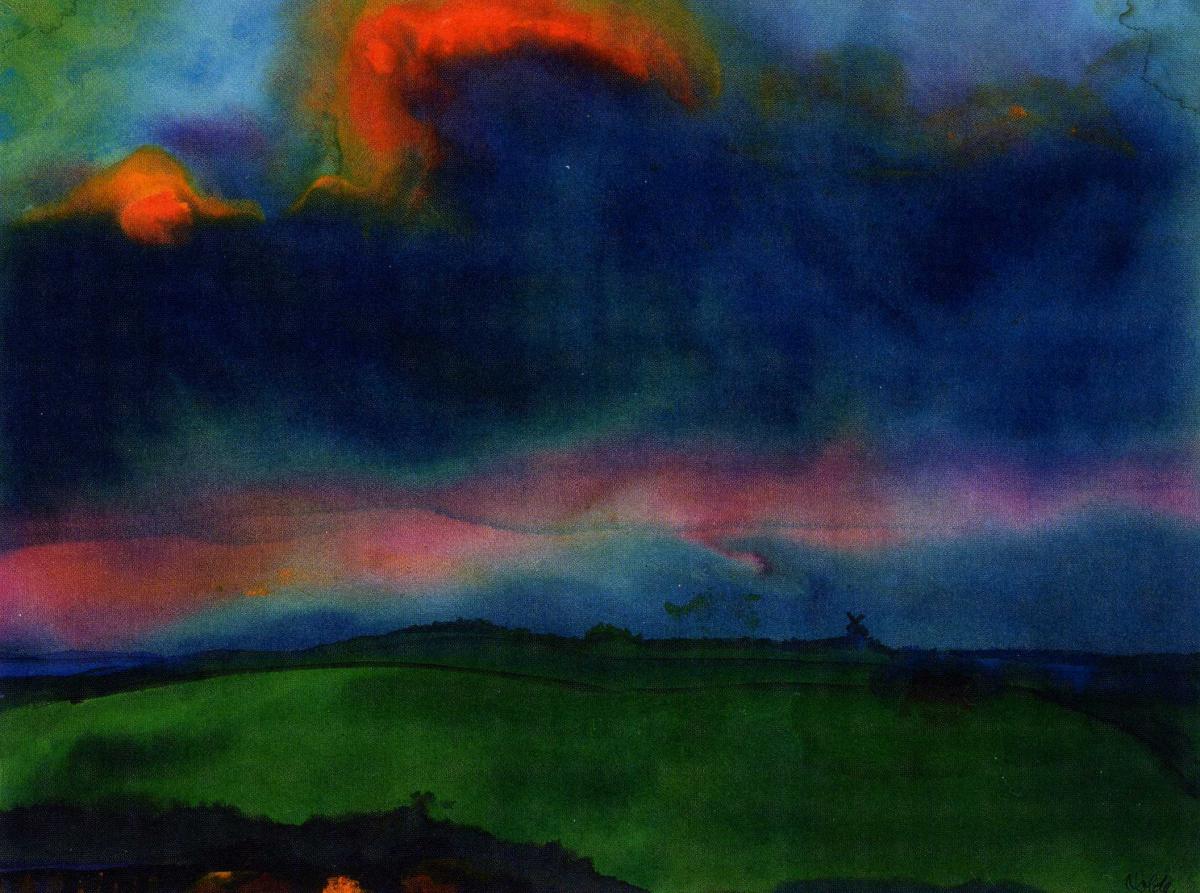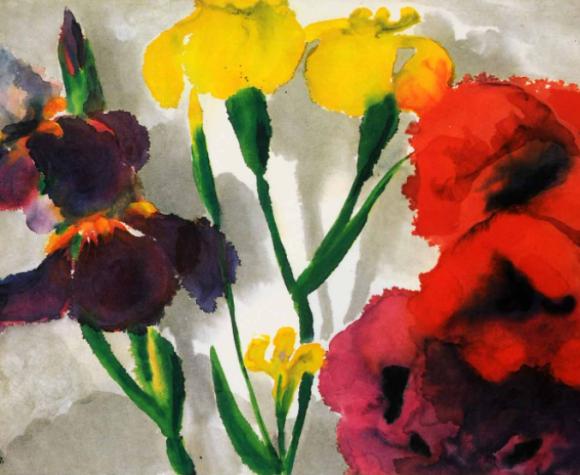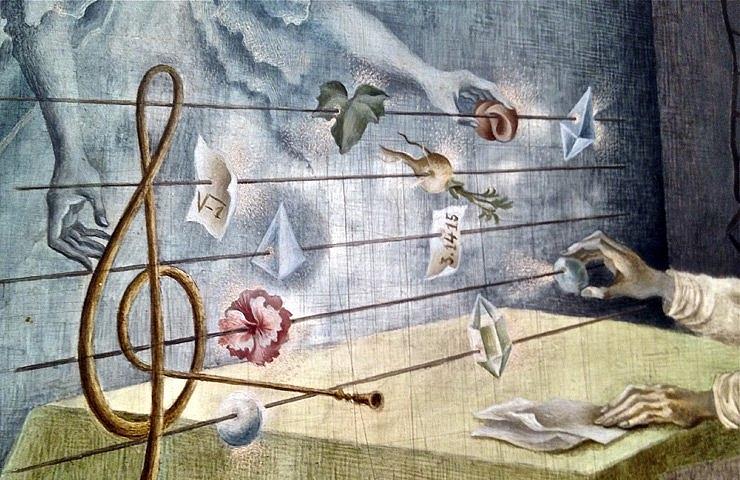Emile Nolde is one of the best known German Expressionist artists. Expressionism was one of several early twentieth century art movements. Artists such as Munch and Kandinsky, wanted their work to express their personal, emotional response to nature and to the human situation, rather than simply to reproduce realistically what they saw. A significant inspiration for the expressionists was primitive art from Africa and the South Pacific, newly available in Paris. They recognized an elemental human response was missing in European art. Nolde wrote, “What looks convincingly true to nature in the old painting is infinitely removed from it.” Expressionists exaggerated color, distorted the figure, ignored natural light and three-dimensional space, and they sought to cause the viewer to reach an emotional rather than an intellectual response. Nolde’s visits to the Ethnological Museum in Paris, and 1913 trip to the South Pacific which passed through Russia, China, Java and Burma was his major influence. In his autobiography he wrote, “primitive men live in their nature: they are one with it and part of the entire universe. I sometimes have the feeling that they are the only real human beings left, while we are something like malformed marionettes, artificial and full of presumption.”
Born in Nolde, a town on the Danish/German border, he grew up with the legends of the Norse gods, which must have conflicted intellectually with his extremely rigid Protestant upbringing. His parents were simple peasants and they did not understand his desire to be an artist. As a compromise, he studied to be a woodcarver and an illustrator. He worked in several furniture factories and taught drawing. In 1898, his application to the Munich Academy was rejected and in 1899, he was unsuccessful as a student at the Academia Julien in Paris.
He was determined to become a painter and more specifically to represent a new German art. By 1900, he developed an intimate and mystically inspired association with nature: “I had an infinite number of visions at this time, for wherever I turned my eyes, nature, the sky, the clouds were alive; in each stone and in the branches of every tree, everywhere my figures stirred and lived there still or wildly animated life, and they aroused my enthusiasm as well as tormented me with their demands that I paint them.” On another occasion he wrote his fiancé that “The wind began to blow, the clouds grew wild and dark, a storm blew up, and the grayish sand was whirling high above the dunes and the houses. A raging storm _ then suddenly my brush ripper through the canvas. I came back to myself, I looked around me: the sun was still beautiful and calm; I had lived through a storm in my imagination and been carried away…The picture was gone. That’s the kind of thing that happens to me.”
Nolde, by choice, lived a reclusive life. He engaged for short intervals with other like minded artists including Munch, Kandinsky and the Blue Rider. After a brief time in public life, he always retreated with his wife to a solitary life on the Island of Alsen on the Black Sea. In 1902, as he became a known artist, he signed his work Nolde, in recognition of his home town.
From 1910-1916, his search for significant subject matter led to create several paintings on New Testament themes, but his raw brushstrokes, bright colors and crude primitive figures where rejected by the churches to which he offered them. I
In 1906-07, he had written that when painting flowers,” I felt as if they loved my hands.” By 1916, he rejected religious subject matter and turned back to nature and to his love of strong colors. “Color the material of the painter: color in their own lives, weeping and laughing, dreams and bliss, hot and sacred, like love songs and the erotic, like songs and glorious chorals! Color is vibration, peeling like silver bells and clanging like bronze bells, proclaiming happiness, passion and love, soul, blood, and death.” IN 1927, the Noldes bought land in Seebuhl, on the German side of the Danish/German border. Here they lived a secluded life. He designed the house with extensive gardens and there he painted hundreds of flowers and paintings of the sea.
Nolde’s politics were controversial. In the early 1920’s, as a proud German who wanted to create a German art, he supported the National Socialist German Worker’s Party, the Danish section. He was anti-Semitic and believed in the theory of racial superiority. In August 1934, he signed the “Call to the Artists,” which meant he accepted Hitler as the German leader. Ironically, Hitler called his art ‘degenerate’, confiscated 1,052 of his works from museums and ordered him not to paint anymore. Many of Nolde’s paintings were included in the now famous 1937, Degenerate Art Exhibition. Nolde was denounced more than any of the other artists. Many historians have researched his autobiography and writing and it is still undetermined where his real sympathies lay and why.
Having been forbidden to paint, he and his wife retreated to their isolated home where their life was difficult. He began his series of “unpainted pictures”, small watercolors of flowers and the sea. These are the images used in this article. His inspiration never flagged. In1942, he wrote, “There is silver blue, sky blue and thunder blue. Every color holds with it a soul, which makes me happy or repels me, and which acts as stimulus. To a person who has no art in him, colors are colors, tones tones…and that is all. All their consequences for the human spirit which range between heaven to hell, just go unnoticed.”
Just before the end of WWII, his studio in Berlin where he stored his finished work was bombed. Over 3000 of his graphic works, watercolors, and drawing were destroyed, along with the works of several other artists, including Paul Klee, whose works were stored there. After liberation in 1945, he began to make oil paintings of his watercolors. He painted over 100 oils in the last 6 years of his life. Later, he was awarded the Pour le Merite medal, established in 1740 by Frederick II of Prussia, in recognition of extraordinary personal achievement. Other recipients include Alfred Einstein and Kathe Kollwitz.
Nolde’s vision of nature is extraordinary. His work, no matter how large or how small, is charged with energy and passion. Having discovered and admired his work long before knowing anything about the artist, his paintings never stop resonating. Nolde the man was a challenging individual. Most of his life he chose separation and isolation from people. The exception was his wife. Never-the-less, his art stands alone and beyond the man. His work was inspired by his deep connection to nature and he had the exceptional ability to render that passion for us to see.
Beverly Hall Smith was a professor of art history for 40 years. Since retiring with her husband Kurt to Chestertown six years ago, she has taught art history classes at WC-ALL and Chesapeake College’s Institute for Adult Learning. She is also an artist whose work is sometimes in exhibitions at Chestertown RiverArts and she paints sets for the Garfield Center for the Arts.








